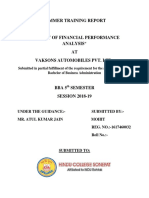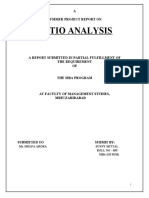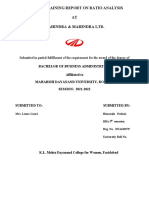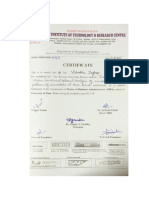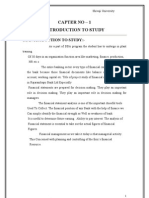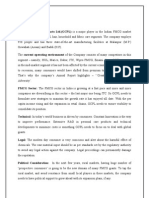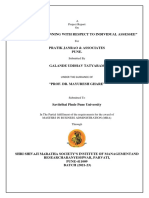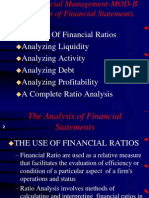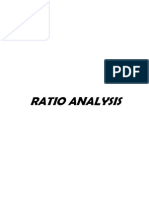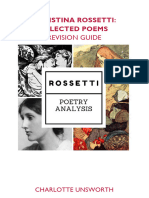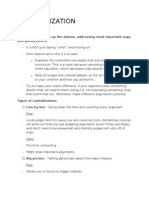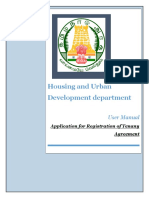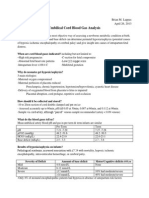Financial Analysis of Hindalco Industries Limited, Renukoot, (U.P)
Uploaded by
alokpatel009Financial Analysis of Hindalco Industries Limited, Renukoot, (U.P)
Uploaded by
alokpatel009SUMMER TRAINING PROJECT REPORT
ON
Financial Analysis of Hindalco Industries Limited, Renukoot, (U.P)
Prepared and Presented to
Under the guidance of
Mr. Vimal Raheja
Senior General Manager
HINDALCO
Submitted in partial fulfillment for the
Award of Degree of Master of Business Administration
from Dr.A.P.J. Abdul Kalam Technical University, Lucknow
BY
Ms. Alka Patel
Roll Number:1412470012
INSTITUTE OF CO-OPERATIVE & CORPORATE MANAGEMENT, RESEARCH AND TRAINING
21/467, RING ROAD, INDIRA NAGAR, LUCKNOW-22601
Page | - 1 -
INTRODUCTION OF FINANCIAL ANALYSIS
The process of evaluating businesses, budgets and other finance-related entities is to
determine their suitability for investment. Typically, financial analysis is used to
analyze whether an entity is stable, solvent, liquid, or profitable enough to be invested
in. When looking at a specific company, the financial analyst will often focus on the
income statement, balance sheet, cash flows statement. In addition, one key area of
financial analysis involves extrapolating the company’s pat performance into an
estimate of the company’s future performance.
FINANCIAL ANALYSIS (also referred to as financial statement analysis or
accounting analysis or Analysis of finance) refer to an assessment of the viability,
stability and profitability of a business, sub-business or project. It is performed by
professionals who prepare reports using ratios that make use of information taken
from financial statements and other reports. These reports are usually presented to top
management as one of the bases in making business decisions.
Continue or discontinue its main operation or part of its business;
Make or purchase certain materials in the manufacture of its products;cquire
or rent/lease certain machineries and equipment in the production of its goods;
Issue stocks or negotiate for bank loan to increase its working capital;
Make decisions regarding investing or lending capital;
Other decisions that allow management to make an informed selection on
various alternatives in the conduct of its business.
TO KNOW
Page | - 2 -
Liquidity
Degree of financial leverage or debt
Profitability
Efficiency
Value
Methods
A. Analyzing liquidity
Liquid assets are those that can be converted into cash quickly. The short-term
liquidity ratios show the firm’s ability to meet its short-term obligations. Thus the
higher ratio (1 & 2) would indicate a greater liquidity and lower risk for short-term
lenders. The Rules of Thumb for acceptable values are: Current Ratio (2:1), Quick
Ratio (1:1).
While high liquidity means that the company will not default on its short-term
obligations, one should keep in mind that by retaining assets as cash, valuable
investment opportunities may be lost. Obviously, cash by itself does not generate any
return. Only if it is invested will we get future return.
1. Current Ratio = Total current assets / total current liability.
2. Quick Ratio= (Total current assets - Inventories ) / total current liabilities
In quick ratio, we subtract inventories from current assets, since they are the least
liquid among the current assets.
Page | - 3 -
B. Analyzing Debt
Debt ratio shows the extent to which a firm is relying on debt to finance its
investments and operations, and how well it can manage the debt obligation, i.e.
repayment of principal and periodic interest. If the company is unable to pay its debt,
it will be forced into bankruptcy. On the positive side, use of debt is beneficial as it
provides tax benefits to the firm, and allows it to exploit business opportunities and
grow.
Note that total debt includes short-term debt (bank advances + the current portion of
long-term debt) and long term debt (debt, leases, and notes payable).
1. Leverage Ratios
i. Debt Equity Ratio = total debt /total equity
This shows the firm’s degree of leverage, or its reliance on external debt for
financing.
ii. Debt Asset Ratio = total debt /total assets
Some analysts prefer to ratio, which also shows the company’s reliance on external
sources for financing its assets. In general, with either of the above ratios, the lower
the ratio, the more, if a company is not using debt; it may be foregoing investment and
growth opportunities. This is a question that con be answered only by further
company and industry research. A frequently cited rule of thumb for manufacturing
and other non-financial industries is that companies not finance more than 50% of
their capital through external debt.
Page | - 4 -
2. Interest Coverage (or times interest earned) Ratio = earnings before
interest and taxes/ annual interest expense.
This shows the firm’s ability to cover fixed interest charges (on both short term &
long- term debt) with current earning. The margin of safety i.e., acceptable varies
within and across industries, and also depends on the earning history of a firm
(specially the consistency of the earning from period to period and year to year)
3. Cash Flow Coverage= net cash flow /annual interest expense
Net cash flow = net income+/- non-cash items (e.g. –equity income+ minority
interest and earnings of subsidiary + deferred income taxes + depreciation +
depletion + amortization expenses)
Since depreciation is usually the largest non cash item in most companies , analyst
often approximate net cash flow as being equivalent to net income + depreciation.
Cash flow is a ‘critical variable’ in assessing a company. If a company is showing
strong profit but has poor cash flow, you should investigate further before passing a
favourable opinion on the company. Analyst prefer ratio 3:2.
C. Analyzing profitability
Profitability is a relative term. It is hard to say that what percentage of profits
represents a profitable firm, as profits depends on such factor as the position of the
company and its products on the competitive life cycle (for example profits will be
lower in initial years when investment is high), on competitive conditions in the
industry, and on borrowing costs.
Page | - 5 -
For decision making, we are concerned only with the present value of expected future
profit. Past or current profit are important only as they help us to identify likely future
profit, by identifying historical and forecasted trends of profit and sale.
We want to know whether profit are generally on the rise; whether sales is stable or
rising; how the profit compared to the industry average; whether the market share of
the company is rising, stable or falling; and other things that indicate the likely future
profitability of the firm.
1. Net profit margin = Profit after taxes / sales
2. Return on asset (ROA) = Profit after taxes/ Total assets
3. Return on equity (ROE) = Profit after taxes/ shareholders’ equity(book
value)
4. Earnings per common share (EPS) = (Profit after taxes – preferred
dividend) / (no. Of common share outstanding)
5. Payout ratio = Cash dividend / net income
Note: the term profits, earnings and net income are often used interchangeably in
financial statements. Be sure to review the statements understand their components.
D. Analyzing efficiency
These ratios reflect how well the firm’s assets are being managed.
The inventory ratio shows how fast the inventory is being produced and sold.
1. Inventory turnover = cost of goods sold/ average inventory
This ratio shows how quickly the inventory is being turned over (or sold) to generate
sales. A higher ratio implies the firm is more efficient in managing inventories by
Page | - 6 -
minimizing the investment in inventories. Thus a ratio of 1:2 would mean that the
inventory turns ½ times, or the average inventory is sold in a month.
2. Total asset turnover ratio= sales/ average total assets
This ratio shows how much sales the firm is generating for every dollar of investment
in assets. The higher the ratio, the better the firm is performing.
3. Accounts receivable turnover= annual credit sales / average receivables
4. Average collection period= average accounts receivables/ (total sales/365)
Ratio #3 and #4 shows the firm’s efficiency in collecting cash from its credit sales.
While a low ratio is good, it could also mean that the firm is being very strict in its
credit policy, which may not attract customers.
5. Days in inventory= Days in a year/ inventory turnover
E. Value ratios
Value ratios show the “embedded value” in stocks, are used by investors as a
screening device before making investments.
For example, a high P/E ratio may be regarded by as some as being a sign of “over
pricing”. When the markets are bullish or if an investor sentiment is optimistic about a
particular stock, the P/E ratio will tend to be high. For example, the late 1990s internet
stocks tended to have extremely high P/E ratios, despite their lack of profits,
reflecting investor’s optimism about the future prospects of these companies. Of
course, the burst of the bubble showed that such confidence was misplaced.
Page | - 7 -
On the other hand, a low P/E ratio may show that company has a poor track record. O
the other hand it may simply be priced too low based on its potential earnings further
investigation is required to determine whether the company would then provide a
good investment opportunity.
1. Price to earnings ratio(P/E)= current market price per share / after- tax
earnings per share
2. Dividend yield= annual dividends per share / current market price per share
Uses and limitation of ratio analysis
1. To evaluate performance, compare to previous years and to competitors and
the industry
2. To set benchmarks or standards for performance
3. To highlight area that need to be improved, or areas that offer the most
promising future potential
4. To enable external parties, such as investors or lenders, to assess the credit
worthiness and profitability of the firm
Limitations
1. These are considerable subjectively involved, as there is no “correct” number
for the various ratios. Further, it is hard to reach a definite conclusion when
some of the ratios are favourable and some are unfavourable.
2. Ratios may not be strictly comparable for different firms due to a variety of
factors such as different accounting practices or different fiscal year periods.
Page | - 8 -
Furthermore, if a firm is engaged in diverse product lines, it may be difficult to
identify the industry category to which the firm belongs. Also, just because a
specific ratio is better than the average does not necessarily mean that the
company is doing well; it is quite possible rest of the industry is doing very
poorly
3. Ratios are based on financial statements that reflect the past and not the future.
Unless the ratios are stable, it may be difficult to make reasonable projections
about future trends. Furthermore, financial statements such as the balance
sheet indicate the picture at “one point” in time, and thus may not be
representative of longer periods.
4. Financial statements provide an assessment of the costs and not value. For
example, fixed assets are usually shown on the balance sheet as the cost of the
assets less their accumulated depreciation, which may not reflect the actual
current market value of those assets.
5. Financial assets do not include all items. For example, it is hard to put a value
on human capital (such as management expertise). And recent accounting
scandals have brought light to the extent of financing that may occur off the
balance sheet.
6. Accounting standards and practices vary among countries, and thus hamper
meaningful global comparisons.
Page | - 9 -
HINDALCO
HINDALCO INDUSTRIES Ltd. Is an Aluminium manufacturing company and is a
subsidiary of the Aditya Birla Group. Its headquarters is at Mumbai, Maharashtra,
India.
The company has an annual sale of US$15 billion and employs around 20,000 people.
It is listed in Forbes Global 2000 at 895th rank. Hindalco is one of the world’s largest
Aluminium rolling companies and one of the biggest producers of primary
Aluminium in Asia.
An industry leader in Aluminium and copper, Hindalco Industries Limited, the metals
flagship company of the Aditya Birla Group is the world's largest Aluminium rolling
company and one of the biggest producers of primary Aluminium in Asia. Its copper
smelter is amongst the largest single location custom smelter globally.
Established in 1958, we commissioned our Aluminium facility at Renukoot in eastern
Uttar Pradesh, India in 1962. Later, acquisitions and mergers with Indal, Birla Copper
and the Nifty and Mt. Gordon copper mines in Australia, strengthened our position in
value-added alumina, Aluminium and copper products.
The acquisition of Novelis Inc. in 2007 positioned us among the top five Aluminium
majors worldwide and the largest vertically integrated Aluminium Company in India.
Today, we are a metals powerhouse present in two of the fastest growing metal
Page | - 10 -
segments; Aluminium and copper, with global footprints in 13 countries and with a
consolidated turnover of USD 14.8 billion (Rs. 80,193 crore).
Aluminium
The major Hindalco products include standard and speciality grade aluminas and
hydrates, aluminium ingots, billets, wire rods, flat rolled products, extrusions and foil.
Copper
Page | - 11 -
Birla Copper upholds its long-standing reputation for quality copper cathodes and
continuous cast copper rods by assuring its management processes meet the highest
standards. Birla Copper also produces precious metals, fertilisers and sulphuric and
phosphoric acid.
Mines
Hindalco acquired two Australian copper mines, Nifty and Mt. Gordon, in 2003. Both
the mines have a long-term life of mine off-take agreement with Hindalco for supply
of copper concentrate to the copper smelter
Page | - 12 -
HINDALCO RENUKOOT
Hindalco Renukoot plant was commissioned in 1962 with one potline and a smelter
of 20,000 TPA capacities. Over the years the plant has increased its capacity through
various brown field expansions and asset sweating measures.
Today Hindalco, at Renukoot, operates across the Aluminium value chain from
bauxite mining, alumina refining, Aluminium smelting to downstream rolling and
extrusions. The integrated facility houses a 700,000tpa alumina refinery and a
345000tpa Aluminium smelter along with facilities for production of semi fabricated
products namely conductor redraw rods, sheet and extrusions.
In 1967 Hindalco established a captive power plant at Renusagar, the first captive
power plant (CPP) for Aluminium industry in India. This along with co-generation
power unit ensures continuous supply of power for smelter and the other operations.
Renukoot has earned the Integrated Management System (IMS) certification
combining quality, environment and occupational health and safety into one business
excellence model. The unit has been a recipient of several national and international
awards in quality, environment management, and energy conservation, CSR, among
others.
As a responsible corporate citizen Hindalco Renukoot’s community Development
Cell plays a leading and exemplary role in the social projects on health care, women’s
empowerment, education and sustainable livelihood schemes. Hindalco Renukoot’s
CSR Cell has taken up various innovative rural development projects in 385
neighbouring villages in the states of Uttar Pradesh, Jharkhand and Chhattisgarh.
These social projects are carried out under the aegis of the Aditya Birla centre for
Community Initiatives and Rural Development spearheaded by Mrs Rajashree Birla
Page | - 13 -
OVERVIEW
A US $41 billion (Rs. 2, 50,000 crore) corporation, the Aditya Birla Group is in the
League of Fortune 500. It is anchored by an extraordinary force of over 120,000
employees, belonging to 42 nationalities.
The Aditya Birla Group has been ranked 4th in the world and 1st in Asia Pacific in
the ‘Top Companies for Leaders’ study 2011, conducted by Aon Hewitt, Fortune
Magazine and RBL (a strategic HR and leadership Advisory firm). The Group has
topped the Nielsen's Corporate Image Monitor 2014-15 and emerged as the Number
one corporate, the 'Best in Class', for the 3rd consecutive year.
Over 50 per cent of the Group’s revenues flow from its overseas operations. It
operates in 36 countries.
ADITYA BIRLA GROUP GLOBAL SCENARIO -
Around the world we are known for:
A metals powerhouse, among the world's most cost-efficient Aluminium and
copper producers. Hindalco-Novelis is the largest Aluminium rolling
company. It is one of the three biggest producers of primary Aluminium in
Asia, with the largest single location copper smelter.
Page | - 14 -
No.1 in viscose staple fibre.
No.1 in carbon black.
The fourth-largest producer of insulators.
The fifth-largest producer of acrylic fibre
Among the top 10 cement producers globally
Among the best energy-efficient fertiliser plants
The largest Indian MNC with manufacturing operations in the USA, wherein
95 per cent of the workforce comprises of Americans
ADITYA BIRLA GROUP- INDIAN SCENARIO
In India, here’s what we have accomplished:
A top fashion (branded apparel) and lifestyle player
The second-largest player in viscose filament yarn
The largest producer in the chlor-alkali sector
Among the top three mobile telephony companies
A leading player in life insurance and asset management
Among the top two supermarket chains in the retail business.
Page | - 15 -
ADITYA BIRLA GROUP-BEYOND BUSINESS
Reaches out annually to 7 million people in 3,000 villages in India through the
Aditya Birla Centre for Community Initiatives and Rural Development,
spearheaded by Mrs. Rajashree Birla.
Focuses on: health-care, education, sustainable livelihood, infrastructure and
espousing social reform.
Runs 42 schools which provide quality education to 45,000 children. Of these
18,000 students belong to the underprivileged segment. Merit Scholarships are
given to an additional 12,000 children from the interiors.
Its 18 hospitals tend to more than a million villagers.
Ongoing education, healthcare and sustainable livelihood projects in
Philippines, Thailand, Indonesia, Egypt, Korea and Brazil, lift thousands of
people out of poverty.
Set up the Aditya Birla India Centre at the London Business School.
Page | - 16 -
HINDALCO BRANDS
ETERNIA ALUMINIUM WINDOWS
Eternia Aluminium Windows, the latest product offering from Hindalco, is where
beauty and engineering come together seamlessly.
Strength and durability meet gorgeous Italian design, great finishes and vivid colour
schemes. And world-class quality meets the best-in-class fabricators to give you
windows that are really worth the view.
Made from aluminium - the 100% green and recyclable metal - Eternia is an ideal
choice to adorn your home with. Eternia Windows are fabricated and installed by a
team of experienced Hindalco-licensed fabricators to give your home the perfect look.
Eternia Windows also come in a wide range of colours and finishes to suit your every
need.
Page | - 17 -
Every Eternia Window is made using precision technology imported from Italy and is
completely customisable to give your home that flawless finish.
FRESHWRAP SUPERWRAP
Hindalco’s aluminium foil brand, Freshwrapp is considered as one of the leading
brands of packaging foils in the country today. Freshwrapp kitchen foil is available
from 10 micron upwards, while Freshwrapp semi-rigid containers are available in a
wide range of sizes and shapes. The largest supplier of foil and laminates in India,
Hindalco’s foil brands include Freshwrapp and Superwrap.
Largest supplier of foil and laminates in the country
Available from 10 microns onwards
Available in multiple colours.
Page | - 18 -
HINDALCO EXTRUSIONS
Hindalco Extrusions is a leading brand for a wide spectrum of industries, including
architectural, electrical, industrial, transport, defence and consumer durables
industries. Our extrusions are manufactured from high-quality billets made out of
virgin in-house metal and offer the widest range of shapes and alloys. A leading
player in the extrusions industry in India, Hindalco offers a wide range of alloys,
including hard alloys and some special alloys for the defence and space sectors.
Leading player in the extrusions industry in India.
Exported to US, Canada, Germany, the UK, France, the Netherlands, South
Africa, UAE, Singapore, Malaysia, Sri Lanka and Bangladesh.
Two extrusions plants: Renukoot and Alupuram.
Page | - 19 -
BIRLA BALWAN
Hindalco’s phosphatic fertilisers are marketed under the brand name Birla Balwan.
Birla Balwan commands a strong market position and is very popular among farmers
in the states of Gujarat, Maharashtra, Madhya Pradesh, Rajasthan, Punjab and
Haryana.
Birla Balwan is sold through private trade channels as well as institutions like co-
operatives and Agro Industry Corp.
Very popular fertiliser
Strong market position.
HINDALCO EVERLAST
Hindalco’s Everlast aluminium roofing and structurals are a hallmark of exceptional
quality and reliability. Available in a wide range of colours and profiles like circular
corrugated, industrial trough (trapezoidal) and tiled finish, Everlast is the preferred
Page | - 20 -
choice for industrial and residential applications for durability and toughness. Everlast
roofing sheets do not rust, have excellent thermal properties, have a high resale value
and are 100 per cent environment friendly.
Everlast aluminium roofing sheets epitomise one of aluminium's outstanding
properties as a building material – its lightness. They are about one third the weight of
corrugated galvanised steel sheets and one seventh that of standard asbestos
corrugated sheets, making it easy to install and ideal for roofing.
Corrosion resistant and has a long life
Easy and fast fabrication
High resale value
A variety of colours and finishes.
Page | - 21 -
HINDALCO MAXLOADER
Hindalco's impressive range of solid and hollow profiles for structurals, beadings,
windows, etc. makes its extrusions a perfect choice for transport. Maxloader™ is an
all-aluminium truck body made of extruded profiles from Hindalco.
Benefits:
Some of the benefits of Maxloader™ aluminium truck bodies are listed below:
1. PAYLOAD ADVANTAGE
The truck with aluminium body has a lighter body weight compared to traditional
containers and can carry more load. Lower weight also translates into additional
savings to the business in terms of increased mileage and less engine and tyre wear.
Page | - 22 -
2. LONG LIFE
Maxloader™ has proved its worth over the years. Its long life ensures that it outlives
the life of any truck. Since aluminium refrigerated and insulated bodies have high
resistance to corrosion and rusting, they are best suited for frozen food and seafood
transport. Aluminium insulated bodies can easily last for 15 years or more.
3. LOWER FABRICATION TIME
The Maxloader™ kit takes less time to fabricate. It is available in a pre-fabricated
mode that can be fitted on the vehicle within 24 hours. Maxloader™ insulated bodies
take far less time for fabrication than the composite type.
Page | - 23 -
VISION, MISSION & VALUES
OUR VISION
To be a premium global conglomerate, with a clear focus on each of the businesses.
OUR MISSION
To relentlessly pursue the creation of superior shareholder value; by exceeding
customer expectation profitably, unleashing employee potential, while being a
responsible corporate citizen and adhering to our values.
OUR VALUES
INTEGRITY
COMMITMENT
PASSION
SEAMLESSNESS
SPEED
Page | - 24 -
Integrity: Acting and taking decisions in a manner that is fair and honest.
Following the highest standards of professionalism and being recognized for doing
so. Integrity for us means not only financial and intellectual integrity, but
encompasses all other forms as are generally understood.
Honesty in every action
Page | - 25 -
Commitment: On the foundation of Integrity, doing all that is needed to
deliver value to all stakeholders. In the process, being accountable for our own
actions and decisions, those of our team and those in the part of the
organization for which we are responsible.
On the foundation of integrity, doing what it takes to deliver, as promised
Page | - 26 -
Passion: An energetic, intuitive zeal that arises from emotional engagement
with the organization that makes work joyful and inspires each one to give his
or her best. A voluntary, spontaneous and relentless pursuit of goals and
objectives with the highest level of energy and enthusiasm.
Missionary zeal arising out of an emotional engagement with work
Page | - 27 -
Seamlessness: Thinking and working together across functional groups,
hierarchies, businesses and geographies. Leveraging diverse competencies and
perspectives to garner the benefits of synergy while promoting organizational
unity through sharing and collaborative efforts.
Thinking and working together across functional silos, hierarchy levels, businesses
and geographies
Page | - 28 -
Speed: Responding to internal and external customers with a sense of
urgency. Continuously striving to finish before deadlines and choosing the
best rhythm to optimize organizational efficiencies.
Responding to stakeholders with a sense of urgency
Page | - 29 -
IMPORTANT MILESTONES
Established in 1857 in the tiny village of Pilani, Rajasthan, the Aditya Birla Group
took shape when Seth Shiv Narayan Birla ventured into cotton trading. Today, with
operations across 36 countries revenues of US$41 billion, the Group is a leading
player in Aluminium, cement manufacturing, viscose staple fibre, chemicals, copper,
insurance services, telecom, branded apparels, fertilisers, software, viscose staple
yarn, carbon black and insulators. We trace the highlights of this remarkable journey,
starting from the present:
2014
The Board of Directors of UltraTech Cement, the largest cement company in
India, approves the acquisition of cement units of Jaiprakash Associates
Limited in Madhya Pradesh in December. The enterprise value of this
acquisition was agreed at Rs.5, 400 crore.
Aditya Birla Chemicals (India) Limited (ABCIL) acquires the chlor-alkali
division of Jayshree Chemicals Limited in September.
Birla Sun Life Asset Management, joint venture between Aditya Birla Group
and Sun Life Financial Inc., acquires Mutual Fund Assets of ING Investment
in May.
Page | - 30 -
2013
First metal tapped at Mahan Aluminium.
Utkal Alumina Refinery goes on stream.
UltraTech Cement acquires the Gujarat Cement Unit of Jaypee Cement
Corporation.
Aditya Birla Chemicals (India) Limited acquires the chlor-alkali and
phosphoric acid divisions of Solaris Chemtech Industries through ABCIL for
Rs.153 crore in May.
2012
Aditya Birla Group [Company name] makes a financial investment of 27.5 per
cent in Living Media India Limited (India Today Group) through a private
investment company in May.
Aditya Birla Group acquires Terrace Bay Pulp Mill in North Western Ontario
in July 2012. Terrace Bay is considered an anchor mill due to its location and
its significant consumption of residual chips produced by regional sawmills.
Aditya Birla Nuvo Limited (ABNL), largest manufacturer of linen fabric in
India, acquires Future Group's Pantaloon format, a part of Pantaloon Retail
(India) Limited (PRIL). The acquisition is in line with the Group's strategic
intent to create the largest integrated branded fashion player in the country.
Page | - 31 -
2011
Refinance of Novelis debt of US$4 billion to enable strategic flexibility for
growth. This was a landmark innovation in financing - not only did Hindalco
get back 50 per cent of the invested equity within four years, but also opened
up a novel funding avenue between Novelis and Hindalco.
Achieved financial closure of two projects through debt financing - Utkal
Alumina for Rs.4, 906 crore and Mahan Aluminium for Rs.7,875 crore.
2010
Expansion of copper rod mill to 160 KTPA.
2009
QIP: Raised US$600 million for projects, the largest straight QIP in India.
2008
Alumina expansion at Muri.
Rights issue: Raised a total of Rs.4, 426 crore for re-financing the bridge loan
taken for the acquisition of Novelis.
Page | - 32 -
2007
Successful acquisition of Novelis, making Hindalco the largest in Aluminium
rolling and among the global top five metals majors, with a presence in 12
countries outside India.
Acquisition of Alcan’s 45 per cent equity stake in the Utkal Alumina project,
thereby making Hindalco the 100 per cent project owner.
2006
Hindalco announces 10:1 stock split. Each share with face value of Rs.10 per
share split into 10 shares of Rs.1 each.
Hindalco completes largest rights issue in the history of Indian capital markets
with a total size of Rs.22, 266 million.
Equity offering and subsequent listing of Aditya Birla Minerals Limited on the
Australian Stock Exchange.
MoU signed with the government of Madhya Pradesh for a greenfield
Aluminium smelter in the Siddhi district of the state.
Page | - 33 -
2005
All businesses of Indal, except for the Kollur foil plant in Andhra Pradesh,
merged with Hindalco Industries Limited.
MoUs signed with the state governments of Odisha and Jharkhand for setting
up greenfield alumina refining, smelting and power plants.
Commissioned Copper III expansion, taking total capacity to 500,000 TPA.
2004
Copper smelter expansion to 250,000 TPA.
2003
Hindalco acquires Nifty copper mine in March 2003, through Aditya Birla
Minerals Limited (ABML, formerly Birla Minerals Resources Pty. Ltd.).
ABML acquires Mount Gordon copper mines in November 2003.
Equity stake in Indal increased to 96.5 per cent through an open offer.
Brownfield expansion of Aluminium smelter at Renukoot to 345,000 TPA.
Page | - 34 -
2002
Amalgamation of Indo Gulf Corporation Limited’s copper business, Birla
Copper, with Hindalco, effective from April 1, 2002.
2000
Acquisition of controlling stake in Indian Aluminium Company Limited
(Indal) with 74.6 per cent equity holding.
1999
Aluminium alloy wheels production commenced at Silvassa.
Brownfield expansion of metal capacity at Renukoot to 242,000 TPA.
1998
Foil plant at Silvassa goes on stream. Hindalco attains ISO 14001 EMS
certification.
1995
Mr. Kumar Mangalam Birla takes over as Chairman of the Hindalco Board.
1991
Beginning of a major expansion programme.
1967
Commissioning of Renusagar power plant – a strategic and far-sighted move.
Page | - 35 -
1965
Downstream capacities commissioned (rolling and extrusion mills) at
Renukoot.
1962
Commencement of production at Renukoot (Uttar Pradesh) with an initial
capacity of 20,000 MTPA of Aluminium and 40,000 MTPA of alumina.
1958
Incorporation of Hindalco Industries Limited
Page | - 36 -
POLICIES AT HINDALCO
QUALITY POLICY
We, at HINDALCO Industries Limited, are committed to pursue and sustain
excellence through continual improvement in all our activities.
To achieve this goal, we shall:
Meet and exceed the expectation of customers with speed, ensuring reliable
and consistent customer service.
Associate with suppliers to ensure high quality of inputs through proactive.
Improve effectiveness of quality management system with emphasis on in-
process control.
Foster team works, educate, train, and involve employees in achieving the
quality objectives.
Establish viable modernization of manufacturing facilities and encourage
technological innovations.
Provide value for money and be globally competitive.
OCCUPATIONAL HEALTH & SAFETY POLICY
We, at HINDALCO Industries Limited, value people as most important resource and
are committed to achieve these goals, we shall:
Inculcate a sense of responsibility related to occupational health and safety
standards.
Page | - 37 -
Develop, sustain and continually improve safe work practices and standards to
safeguard employees, contractors, community and assets.
Comply with all prevalent statutory and regulatory requirements related to
occupational health and safety.
Promote and enhance safety awareness and consciousness amongst all
employees, through training and development.
Monitor and review health and safety management systems and working
conditions periodically.
ENVIRONMENTAL AND ENERGY POLICY
We, at HINDALCO Industries Limited, a premier name in Aluminium and
Copper, operating across the process chain from mining to semi-fabricated
products stand committed to continually strengthen our energy efficiency and
environmental performance in order to achieve Sustainable Development. To
achieve this, we shall.
Institutionalize an Energy & Environmental Management System across all
production and operations activities, which can be monitored through periodic
audits.
Comply with all applicable legislations and go beyond wherever techno-
economically viable.
Enhance material efficiency, achieve high process/equipment productivity and
adopt pollution prevention practices.
Page | - 38 -
Adopt energy efficient and cleaner technologies, appropriate to the region in
which we operate and in line with our heat recovery and incorporate
technological interventions reduce Green House Gases(GHG) from our
operations.
Reduce open land storage of wastes and take active measures to promote
industrial recycling and re-use.
Work in partnership with regulatory authorities, relevant suppliers, contractors
and stakeholders to meet the requirements of this policy.
CORPORATE SOCIAL RESPONSIBILITY POLICY
We, the employees of HINDALCO Industries Limited are committed to realize our
Group’s social vision to actively contribute to the socio-economic development of the
underprivileged communities around us for a better, sustainable way of life and
thereby help raise the country’s Human Development Index. While adopting the
principles of Sustainable Development, we shall fulfil our responsibility as a good
corporate citizen through a comprehensive plan which will focus on:
Health, Sanitation and Family Welfare.
Primary & Adult Education.
Sustainable Livelihood through income generation, agriculture based
programmes including watershed Development.
Women’s Empowerment through Self Help Groups.
Infrastructural Development & Support. Espousing Social Causes with the
overall aim of building long term socio-economic.
Page | - 39 -
SWOT ANALYSIS
STRENGTHS
An industry leader in aluminium and copper
Hindalco, the metals flagship company of the Aditya Birla Group, is the world's
largest aluminium rolling company and one of the biggest producers of primary
aluminium in Asia. Its copper smelter is the world’s largest custom smelter at a single
location. The company also made investments of strategic importance, which further
scaled its market presence.
Integrated aluminium operations
The company is the largest vertically integrated aluminium company in India. It
engages in all aspects of the value chain from bauxite mining, alumina refining, and
aluminium smelting to downstream rolling, extrusions, and recycling.
Extensive product portfolio
Hindalco offers an extensive product portfolio through its two segments, aluminium
and copper. The aluminium segment engages in the production of rolled products,
extrusions, ingots, billets, wire rods, slabs, foil, roofing sheets, and waterproofing
membrane sheeting. The copper segment produces continuous cast copper rods,
copper cathodes, di-ammonium phosphate (dap), phosphor-gypsum, phosphoric acid,
precious metals, and sulphuric acid.
Page | - 40 -
WEAKNESS
Technology is not upgraded compared to global giants in Aluminium industry.
Complexity of operation.
Present production capacity is not adequate to meet the rising high demand.
High cost of establishment and maintenance of plants.
Transportation cost for procurement of raw materials is also high.
OPPORTUNTIES
Growing demand for aluminium
Hindalco, which is engaged in the production of aluminium serving customers in
more than 50 countries, is better positioned to benefit from the positive outlook for
the global aluminium industry.
Investment to expand aluminium operations
Hindalco has undertaken several projects to expand its aluminium operations. For
instance, the construction of an alumina refinery along with a 90 MW captive co-
generation plant at Orissa (the Utkal Alumina refinery project), the Mahan
Aluminium which is a smelter-power plant complex with a 359,000 tpa aluminium
smelter and a 900 MW captive thermal power plant in Madhya Pradesh. the Aditya
Aluminium project in Orissa, which includes a 359,000 tpa aluminium smelter and a
900 MW captive power plant
Page | - 41 -
THREATS
Mining and production risks
Hindalco is subject to operating risks in its mining and production activities. Due to
these risks, the company is liable to incur higher mining, transportation, or production
costs, disrupt or halt operations at its mines and production facilities permanently or
for varying lengths of time, or interrupt the transport of its products to the customers.
Intense competition
There is substantial competition in the copper and aluminium industries, both in India
and internationally which threatens to erode the market share of the company.
Page | - 42 -
OBJECTIVES OF STUDY
The objectives to work and prepare the report were:
To analyse and evaluate the financial performance of Hindalco Industries
Ltd. In terms of Balance Sheet, Income Statement and Ratios Analysis of
financial performance.
To compare its actual performance to the expected one.
To make suggestion and recommendation for improving the financial
position.
To study the policies of the company wrt to the financial management.
To identify the financial strength, weakness, opportunity and threats that
the firm might have.
To study company’s functioning in
To Financial Management
Allocation of resources.
Page | - 43 -
RESEARCH METHODOLOGY
SAMPLING PLAN
There is no sampling plan as such as the study involved in understanding the various
processes and analyses of Hindalco Industries Limited.
SOURCES OF DATA
Most of the data’s are collected from secondary sources like
Internet
Annuals report of HINDALCO INDUSTRIES ltd.
Data base
Books
ANALYSIS OF DATA
Microsoft Excel Sheet is used for the analysis of data. Graphs and tables are made for
the comparison of the data and for making the interpretation easier.
TOOLS USED
The project is descriptive and analytical in Nature
Page | - 44 -
TOPIC COVERED
Financial tools
Financial analysis of Hindalco
Interpretation of ratios
Data tabulation
FINANCIAL TOOLS
Comparative statement
It is a statement which compares financial data from different periods of time. The
comparative statement lines up a section of the income statement, balance sheet or
cash flow statement with its corresponding section from a previous period. It can be
used to compare financial data from different companies over time, thus revealing the
trend in the financials.
Trend analysis
An aspect of technical analysis that tries to predict the future movement of a stock
based on past data. Trend analysis is based on the ideas that what happened in the past
gives traders an idea that what has happened in the past gives traders an idea of what
will happen in the future.
Page | - 45 -
Ratio Analysis
Quantitative analysis of information contained in a company’s financial statements.
Ratio analysis is based on line items in financial statements like the balance sheet,
income statement; the ratios of one item – or a combination of items – to another item
or combination are then calculated. Ratio analysis is used to evaluate various aspects
of company’s operating and financial performance such as its efficiency, liquidity,
profitability and solvency. The trend of these ratios over time is studied to check
whether they are improving or deteriorating. Ratios are also comparative valuations.
Ratio analysis is a cornerstone of fundamental analysis.
Ratio analysis as a tool possesses several important features. The data, which are
provided by financial statement, are readily available. The computation of ratios
facilitates the comparison of the firms which differ in size. Ratios can be used to
compare a firm’s financial performance with industry averages. In addition, ratios can
be used in a form of trend analysis to identify areas where performance has improved
or deteriorated over time.
Because ratio analysis is based upon accounting information, its effectiveness is
limited by the distortions which arise in financial statements due to such things as
historical cost accounting and inflation. Therefore, ratio analysis should only be used
as a first step in financial analysis, to obtain a quick indication of the firm’s
performance and to identify areas which need to be investigated further.
Page | - 46 -
Financial Cash Flow
Cash flow is the movement of money into or out of a business, project, or financial
product. It is usually measured during a specified, limited, limited period of time.
Measurement of cash flow can be used for calculating other parameters that gives
information on a company’s value and situation. Cash flow can be used, for example,
for calculating parameters: it discloses cash movements over the period.
To determine a project’s rate of return or value. The time of cash flow into and
out of projects are used as inputs in financial models such as internal rate of
return and net present value.
To determine problem in business’s liquidity. Being profitable does not
necessarily mean being liquid. A company can fail because of a shortage of
cash even while profitable.
To evaluate the risks within a financial product, e.g., matching cash
requirement, evaluating default risk, re-investment requirement, etc.
Cash flow can be used to evaluate the ‘quality’ of income generated by accrual
accounting. When net income is composed of large non-cash items it is
considered low quality.
Cash flow notion is based loosely on cash flow statement accounting standards. It’s
flexible as it can refer to time intervals spanning over past-future. It can refer to the
total of all flows involved or a subset of those flows. Subset terms include net cash
flow, operating cash flow and free cash flow.
Page | - 47 -
Financial cash flow equation
Operating cash flow = EBIT + Depreciation – Taxes
Capital Spending = Ending Net Fixed Assets
– Beginning Net Fixed Assets +
Depreciation
Addition to NWC = Ending NWC – Beginning NWC
Net Working Capital = current asset – Current Liabilities
Cash Flow from Assets =Operating Cash Flow
– Capital Spending – Additions to NWC
Cash Flow to Debt holders = Interest Expenses
– Ending Long-term Debt
+ Beginning Long-term Debt
Cash Flow to Common Stockholders =dividends paid
– (Ending Common Stock - beginning
common stock)
-(Ending Capital Surplus – Beginning
Capital Surplus)
+ (Ending Treasury Stock – Beginning
Treasure Stock)
Page | - 48 -
Cash flow to Preferred Stockholders =Preferred dividends paid
- (Ending Preferred Stock - Beginning
Preferred Stock)
Cash Flow to Investors = cash flow to debt holders
+ Cash flow to common stockholder
Operating Cash Flow
Operating cash flow measures the cash flows generated by firm’s main operations. (In
effect, the ability of the firm to sell its products for more than the cost of production).
Operating cash flow can be determined as follows:
Operating cash flow = EBIT + Depreciation – Taxes
The calculation begins with the EBIT (Earnings before Interest and Taxes) because
Interest Expenses is not a cash flow that operations are dependent upon. Interest
Expenses reflects how the firm choose to finance its assets, not its ability to operate
them successfully. Depreciation Expenses (from the Income Statement) is added back
because it is a non-cash expense which was subtracted out in the determination of
EBIT. Finally, the taxes which the firm actually paid in cash during the period are
subtracted.
Page | - 49 -
Capital Spending
Capital spending reflects the firm’s net investment in fixed assets during the period. It
can be calculated as follows:
Capital spending = Ending Net Fixed Assets – Beginning Net Fixed Assets +
Depreciation
In this calculation, Depreciation Expenses (from the Income Statement) must be
added back because the balance for Ending Net Fixed Assets on the Balance Sheet is
reduced by the Depreciation Expenses which was incurred during the period.
Additions to Net Working Capital
Additions to Net Working Capital measure the firm’s investment in Net Working
Capital during the period. Net Working Capital (NWC) is defined as Current Assets
minus Current Liabilities.
Addition to NWC = Ending NWC – Beginning NWC
Cash Flow from Assets
Once the above items have been determined, the Cash Flow from the Firm’s Assets
can be calculated as follows:
Cash Flow from Assets = Operating cash flow – Capital Spending - Additions to
NWC
Page | - 50 -
A healthy firm would be expected to generate positive cash flow. However, if the firm
is young and / or is investing heavily to promote growth, then a negative Cash Flow
from the Firm’s Assets may be excused.
Cash Flow to Common Stakeholders
The principal cash from the firm to its Common Stockholders is dividends. Firms also
issue new stock periodically. This represents a cash flow the Common Stockholders
to the firm. (Some firms also repurchase their own stocks, i.e., a cash flow from the
firm to its stockholders). When this occurs the repurchased shares are recorded on the
Balance Sheet as Treasury Stock. The Cash Flow to common stockholders can be
calculated as common dividends paid less net new common equity raised.
Cash Flow to Common Stakeholders = Dividends paid – (Ending common stock
– beginning Common Stock) - (Ending Capital Surplus – Beginning Capital
Surplus) + (Ending Treasury Stock - Beginning Treasure Stock)
Cash Flow to Preferred Stockholders
The Cash Flow to Preferred Stockholders is defined as preferred Dividends Paid less
net new Preferred Equity raised.
Cash Flow to Preferred Stockholders = Preferred Dividends Paid – (Ending
Preferred Stock - Beginning Preferred Stock)
For example, if there is no Preferred Stock. Thus the Cash Flow to Preferred
Stockholders for the firm is 0.
Page | - 51 -
Cash Flow to Investors (Debt holders and Equity holder)
Once the above items have been determined, the Cash Flow to the Investors in the
Firm can be calculated as follows:
Cash Flow to Invest
ors = Cash Flow to Debt holders + Cash flow to Common Stock holders + cash
Flow to Preferred Stock holders
Cash Flow to Debt holders
The cash flow of debt holders is defined as debt service less new long-term
borrowings. (Debt service represents interest expense and repayment of principal). An
equivalent definition which makes use of values which can readily be obtained from
the Balance Sheet and Income Statement is interest expenses less net new borrowings.
This can be calculated as follows:
Cash Flow to Debt holders = Interest Expense – Ending Long-term Debt +
Beginning Long-term Debt
Interest expenses are the fundamental cash Flow from the firm to its debt holders.
Moreover, if a firm’s long-term Debt increases from 1 year to the next (i.e., more new
debt was issued than was repaired) then the debt holders supplied the firm with
additional cash.
Page | - 52 -
BALANCE SHEET OF HINDALCO INDUSTRIES LIMITED
A balance sheet, also known as a “statement of financial statement position”, reveals a
company’s assets, liabilities and owner’s equity (net worth).
This analysis is considered generally at set intervals of time, like annually or
quarterly. The process of balance sheet analysis is used for deriving actual figures
about the revenue, assets, and liabilities of the company.
Balance Sheet as on 31st March, 2014 Rs. (crore)
As on 31/03/2014 As on
31/03/2013
EQUITY AND LIABILITIES
Shareholders’ funds
Share capital 206.48 191.48
Reserve and surplus 36525.97 33239.60
Money received against share warrants _ 541.31
36732.45 33972.39
Non-Current Liabilities
Long-Term Borrowings 22108.58 20443.05
Page | - 53 -
Deferred Tax Liabilities (Net) 1174.31 1191.14
Other Long-Term Liabilities 830.86 074.28
Long-Term Provisions 341.96 300.94
24455.71 22909.41
Current Liabilities
Short-Term Borrowings 4258.37 3701.72
Trade Payables 4383.75 3044.05
Other Current Liabilities 2901.91 1921.09
Short-Term Provisions 1037.76 1066.90
12581.79 9736.76
73769.95 66618.56
ASSETS
Non-Current Assets
Fixed assets:
Tangible assets 18024.98 7071.00
Intangible assets 29.73 26.65
Capital work in progress 17277.13 23605.11
Intangible assets under development 0.10 0.01
35331.94 30702.77
Page | - 54 -
Non-Current Investments 15312.45 14050.17
Long Term Loans and Advances 1161.15 1681.08
Other Non Current Assets 12.52 34.51
51818.06 46468.53
Current Assets
Current Investments 6595.01 6431.96
Inventories 8914.58 7702.61
Trade Receivables 1283.65 1515.04
Cash and Bank balances 1163.17 1497.82
Short term Loans and Advances 3226.40 2261.73
Other Current Assets 769.08 740.87
21951.89 20150.03
73769.95 66618.56
Page | - 55 -
INCOME STATEMENT OF HINDALCO INDUSTRIES LIMITED
Income Statement is a financial statement that summarizes the various transaction of a
business during a specified period, showing the net profit or loss.
Income statement measures the company’s financial performance over a specific
accounting period. It is often referred as a Profit And Loss Statement.
Income statement for the year ending 2013&2014
Rs. (crore)
Year Ended Year
31/03/2014 Ended
31/03 2013
INCOME
Gross Revenue from Operation 30101.34 28069.78
Less: Excise Duty 2250.41 2012.85
Net Revenue from Operations 27850.93 26056.93
Other income 1124.42 983.09
Total income 28975.35 27040.02
EXPENSES
Purchase of Stock in Trade 0.03 0.38
Cost Of Materials Consumed 18804.28 17,136.51
Page | - 56 -
Change in Inventories (676.21) 127.94
Employees Benefits Expenses 1346.10 1200.80
Power and Fuel 3557.61 3073.04
Finance Costs 711.65 435.98
Depreciation and Amortization 823.29 686.95
Impairment Loss/(Reversal) (Net) - 17.25
Other Expenses 2327.24 2314.54
Total Expenses 26893.99 24993.39
Profit Before Exceptional Items and Tax 20381.36 2046.6
Exceptional Items 395.98 -
Profit Before Tax 1685.38 2046.63
Tax expenses:
Current Tax 288.88 381.41
Deferred Tax (16.83) (33.98)
Profit for the year 1413.33 1699.20
Page | - 57 -
CASH FLOW STATEMENT
The statement of cash flows is part of the financial statements issued by a business,
and describes the cash flows into and out of the organization. Its particular focus is on
the types of activities that create and use cash, which are operations, investments, and
financing. Though the statement of cash flows is generally considered less critical
than the income statement and balance sheet, it can be used to discern trends in
business performance that are not readily apparent in the rest of the financial
statements. It is especially useful when there is a divergence between the amount of
profits reported and the amount of net cash flow generated by operations.
There can be significant differences between the results shown in the income
statement and the cash flows in this statement, for the following reasons:
There are timing differences between the recordation of a transaction and
when the related cash is actually expended or received.
Management may be using aggressive revenue recognition to report revenue
for which cash receipts are still some time in the future.
The business may be asset intensive, and so requires large capital investments
that do not appear in the income statement, except on a delayed basis as
depreciation.
Many investors feel that the statement of cash flows is the most transparent of the
financial statements (i.e., most difficult to fudge), and so they tend to rely upon it
more than the other financial statements to discern the true performance of a
business.
Cash flows in the statement are divided into the following three areas
Page | - 58 -
Operating activities - These constitute the revenue-generating activities of a
business. Examples of operating activities are cash received and disbursed for
product sales, royalties’ commissions, fines, lawsuits, supplier and lender
invoices, and payroll.
Investing activities - These constitute payments made to acquire long-term
assets, as well as cash received from their sale. Examples of investing
activities are the purchase of fixed assets and the purchase or sale of securities
issued by other entities.
Financing activities - These constitute activities that will alter the equity or
borrowings of a business. Examples are the sale of company shares, the
repurchase of shares, and dividend payments.
Cash flow statement for the year ending 2013&2014
(Rs.crore)
For the year ended For the year ended
31 March 2014 31 March 2013
A. Cash flow from operating activities
Net profit before tax 1,685.38 2,046.63
Adjustment for: 0.00 0.00
Page | - 59 -
Finance Costs 711.65 435.98
Depreciation and Amortization 823.29 686.95
Impairment Loss/ (Reversal) (Net) 0.00 17.25
Employee Stock Option Scheme 3.71 0.27
Provisions/ Provisions written-back
(Net) -0.09 14.24
Unrealized Foreign Exchange (Gain)/
Loss (Net) 22.70 6.03
Loss/ (Gain) on Derivative
transactions (Net) -141.45 17.87
Investing Activities (Net) -1,048.55 -935.54
Operating profit before working
capital changes 2,056.64 2,289.68
Changes in working capital:
Inventories -1254.54 40.24
Trade and other Receivables -568.99 -407.48
Page | - 60 -
Trade and other Payables 2035.35 -1638.03
Cash generated from operation 2268.46 284.41
Payment of direct taxes -237.09 -636.75
Net cash generated/(used) -
operating activities 2031.37 -352.34
B. Cash flow from investing activities
Purchase of fixed assets -3,457.58 -5,530.84
Sale of fixed assets 10.24 20.69
Return of Capital from Subsidiary
(Net) -1,242.49 -541.58
Purchase / sale of shares of
subsidiaries (net) -1,242.49 -541.58
Purchase / sale of investments (net) 28.64 -1,454.91
Proceeds/ Repayment of Loans and
Deposits (Net) 577.95 -1,249.09
Interest received 443.15 254.01
Page | - 61 -
Dividend received 237.04 259.65
Net cash generated / (used) -
investing activities -3,403.05 -8,242.07
C. Cash flow from financing activities
Proceeds from issue of shares (net of
expenses) 1623.99 0.4
Capital Subsidy Received 0.5 4.5
Proceeds from Long-term
Borrowings 16786.72 14818.09
Repayment of Long-term Borrowings -369.63 -1.53
Prepayment of Long-term
Borrowings -14513.72 -5142.99
Proceeds/ Repayment of Short-term
Borrowings (Net) 655.85 258.55
Finance Cost Paid -2303.12 -1519.85
-279.4 -331.01
Dividend Paid (including Dividend
Page | - 62 -
Distribution Tax)
Net Cash Generated/ (used) -
Financing Activities 1601.19 8086.16
Net increase / (decrease) in cash
and cash equivalents 229.51 -508.25
Add: opening cash and cash
equivalents 205.38 713.63
Close cash and cash equivalents 434.89 205.38
Notes:
The Cash Flow Statement has been prepared under the indirect method as set out in
Accounting Standard.
(AS) 3:"Cash flow Statement" as specified in the Companies (Accounting Standard)
Rule 2006.
Figures for the previous period have been regrouped / rearranged wherever
found necessary.
Page | - 63 -
CONCLUSION:
Cash from operation was significantly higher compared to last year due to decrease in
working capital by Rs. 212 crore against an increase of Rs. 2005 crore last year. Net
increase in borrowing of Rs. 2559 crore was mainly to finance the capital expenditure
of Rs. 3447 crore and working capital. Company received Rs. 1624 crore from issue
of equity shares against outstanding preferential warrants.
Page | - 64 -
RATIO ANALYSIS OF HINDALCO INDUSTRIES LIMITED
PROFITABILITY RATIO
A profitability ratio is a measure of profitability, which is a way to measure a
company's performance. Profitability is simply the capacity to make a profit, and a
profit is what is left over from income earned after you have deducted all costs and
expenses related to earning the income. The formulas you are about to learn can be
used to judge a company's performance and to compare its performance against other
similarly-situated companies.
Return on Total Assets (ROTA)
Return on Capital Employed(ROCE)
Return on Total Assets (ROTA): Return on Assets measures how effectively
the company produces income from its assets. You calculate it by dividing net
income (NI) for the current year by the value of all the company's assets (A)
and multiplying the quotient by 100:
Page | - 65 -
Return on Assets = Net Income / Assets * 100
The ROTA of the Hindalco Industries Limited for the last five year:
RATIO
YEAR 2013-14 2012-13 2011-12 2010-11 2009-10
ROTA 177.92 174.61 164.48 155.12 145.85
Page | - 66 -
INTERPRETATION
This shows permanently rise in total asset.
Positive rise in ratio indicates a positive efficiency of the organization.
High ROTA indicate that the company is investing wisely and is likely
profitable.
Low ROTA indicate that the company is not investing wisely.
Return On Capital Employed (ROCE): A ratio that indicates the
efficiency and profitability of a company’s capital investment.
ROCE = Earnings before interest and tax * 10
Capital Employed
RATIO
YEAR 2013-14 2012-13 2011-12 2010-11 2009-10
ROCE 4.30 4.16 6.34 7.03 7.14
Page | - 67 -
INTERPRETATION
This ratio shows decrease in return over capital employed.
Decrease in ratio indicate non favorable for business organization.
Low ROCE state that a company is making poor use of its capital
resources.
A high ROCE indicates that a larger of profits can be invested back
into the company for the benefit of shareholders.
Page | - 68 -
MANAGEMENT EFFICIENCY RATIO
Accounting ratios measure a firm’s ability to convert different accounts within their
balance sheets into cash or sales. These ratios indicate how efficiently the working
capital and stock being used to obtain sales. Higher Activity Ratios indicates the
better use of capital and resources and in turn lead to higher profitability. The Asset
Turnover Ratio and Inventory Turnover Ratio are good example of Activity Ratios.
Inventory Turnover Ratio (ITR): This ratio indicates the relationship
between the cost of goods sold during the year and average stock kept during
that year. A low turnover implies poor sales and, therefore, excess inventory.
A high ratio implies either strong sales or ineffective buying.
ITR = Cost of goods sold/ Average Inventory
RATIO
YEAR 2013-14 2012-13 2011-12 2010-11 2009-10
ITR 3.12 3.38 3.80 3.43 3.63
Page | - 69 -
INTERPRETATION
The operational efficiency of the business concern is good.
Here the ratio stand out to be 3.12 from the last year 3.38, which shows
decrease in ITR.
A low turnover implies poor sales and excess inventory.
A high ratio implies strong sales.
Page | - 70 -
Debtor Turnover Ratio (DTR): Receivable Turnover Ratio or Debtor's
Turnover Ratio is an accounting measure used to measure how effective a
company is in extending credit as well as collecting debt.
A high turnover ratio indicates a combination of a conservative credit policy and an
aggressive collections department, as well as a number of high-quality customers.
A low turnover ratio represents an opportunity to collect excessively old accounts
receivable that are unnecessarily tying up working capital. Low receivable turnover
may be caused by a loose or nonexistent credit policy, an inadequate collections
function, and/or a large proportion of customers having financial difficulties. It is also
quite likely that a low turnover level indicates an excessive amount of bad debt.
DTR = Net Sales/ Average Debtors
RATIO
YEAR 2013-14 2012-13 2011-12 2010-11 2009-10
DTR 19.90 17.71 19.72 18.41 15.48
Page | - 71 -
INTERPRETATION
The quality of receivable is good.
The liquidity position of a concern is adequate.
A high turnover ratio indicates a combination of a conservative credit policy
and an aggressive collections department, as well as a number of high-quality
customers.
A low turnover ratio represents an opportunity to collect excessively old
accounts receivable that are unnecessarily tying up working capital.
Page | - 72 -
Fixed Assets Turnover Ratio (FATR): The fixed-asset turnover ratio measures
a company's ability to generate net sales from fixed-asset investments -
specifically property, plant and equipment (PP&E) - net of depreciation.
The fixed asset turnover ratio compares net sales to net fixed assets.
A high ratio indicates that a business is:
Doing an effective job of generating sales with a relatively small amount of
fixed assets
Outsourcing work to avoid investing in fixed assets
Selling off excess fixed asset capacity
A low ratio indicates that a business:
Is over invested in fixed assets.
Needs to issue new products to revive its sales.
Has made a large investment in fixed assets, with a time delay before the new
assets start generating revenues.
FATR = Net Sales/ Average Fixed assets
RATIO
YEAR 2013-14 2012-13 2011-12 2010-11 2009-10
FATR 1.04 1.74 1.85 1.67 1.42
Page | - 73 -
INTERPRETATION
Here the ratio stands to be 1.04 and before it was 1.74 which states that
there is a minor change in ratio.
A ratio indicate that a business is doing an effective job of generating
sales with relatively small amount of fixed asset.
A low ratio indicate that a business is over invested in fixed asset.
Page | - 74 -
LIQUIDITY AND SOLVENCY RATIO
A liquidity ratio is an indicator of whether a company's current assets will be
sufficient to meet the company's obligations when they become due. The liquidity
ratios include the current ratio and the acid test or quick ratio. The current ratio and
quick ratio are also referred to as solvency ratios.
The solvency ratio is only one of the metrics used to determine whether a company
can stay solvent. Other solvency ratios include debt to equity, total debt to total
assets, and interest coverage ratios.
Debt Equity Ratio: The debt-to-equity ratio (D/E) is a financial ratio
indicating the relative proportion of shareholders' equity and debt used to
finance a company's assets. Closely related to leveraging, the ratio is also
known as Risk, Gearing or Leverage.
A high debt-to-equity ratio indicates that a company may not be able to generate
enough cash to satisfy its debt obligations.
However, a low debt-to-equity ratio may also indicate that a company is not taking
advantage of the increased profits that financial leverage may bring.
DEBT EQUITY RATIO = Long Term Debt/ Net Worth
Page | - 75 -
RATIO
YEAR 2013-14 2012-13 2011-12 2010-11 2009-10
DER 0.74 0.72 0.45 0.30 0.23
INTERPRETATION
Debt equity ratio is increasing every year.
Here the ratio stand out to be 0.74 from the last year ratio 0.72,there is no
major change in the debt equity ratio of the organization.
A high debt to equity ratio indicates that a company may not be able to
generate enough cash to satisfy its debt obligations.
A low debt-to-equity ratio may also indicate that a company is not taking
advantage of the increased profits that financial leverage may bring.
Page | - 76 -
Current ratio: The current ratio is a financial ratio that measures whether
or not a firm has enough resources to pay its debts over the next 12 months. It
compares a firm's current assets to its current liabilities.
A high current ratio can be a sign of problems in managing working capital.
When a current ratio is low and current liabilities exceed current assets
(the current ratio is below 1), then the company may have problems meeting its
short-term obligations (current liabilities).
Current ratio = current assets/ current liabilities
RATIO
YEAR 2013-14 2012-13 2011-12 2010-11 2009-10
CURRENT 1.11 1.26 1.01 0.96 1.02
RATIO
Page | - 77 -
INTERPRETATION
There is no major change in the current ratio of the organisation .
Higher value of current ratio indicate more liquid of the firm ability to pay
current obligation in time.
Lower value indicate current liabilities exceed current ratio and may have
problem in meeting current obligations in time.
The ideal current ratio of 2: 1 is considered to be satisfactory.
Quick ratio: The quick ratio is a financial ratio used to gauge a company's
liquidity. The quick ratio is also known as the acid test ratio. The quick ratio
differs from the current ratio in that some current assets are excluded from
the quick ratio. The most significant current asset that is excluded is inventory.
Low or decreasing quick ratios generally suggest that a company is over-leveraged,
Page | - 78 -
struggling to maintain or grow sales, paying bills too quickly or
collecting receivables too slowly.
On the other hand, a high or increasing quick ratio generally indicates that a company
is experiencing solid top-line growth, quickly converting receivables into cash, and easily
able to cover its financial obligations. Such companies often have faster inventory
turnover and cash conversion cycles.
Quick Ratio = Cash in hand + Cash at bank + Marketable securities
Current Liabilities
RATIO
YEAR 2013-14 2012-13 2011-12 2010-11 2009-10
QUICK 0.71 0.91 0.55 0.34 0.39
RATIO
Page | - 79 -
INTERPRETATION
Here the ratio 0.71 as before it was 0.91 that proves the organization’s position
is good.
Low or decreasing quick ratios generally suggest that a company is over-
leveraged, struggling to maintain or grow sales, paying bills too quickly or
collecting receivables too slowly .
A high or increasing quick ratio generally indicates that a company is
experiencing solid top-line growth converting receivables into cash and easily
able to cover its financial obligations.
The ideal quick ratio of 1:1 is considered to be satisfactory.
Page | - 80 -
FINANCIAL ANALYSIS AND REVIEW
Revenue
Revenue for the year increased 7% to Rs. 27851 crore. Profit before interest
and depreciation was Rs. 3616 crore vs. Rs. 3187 crore in FY13, a jump of
13%.
Other income
Other income at rs. 1124 crore was higher on account of better yields, higher
treasury corpus and dividend from subsidiaries.
Interest
Business, finance for went up from Rs. 566 crore to Rs. 712 crore due to
increase in debt level in line withdrawal of new debt and capitalization of new
project.
Depreciation
Depreciation charges (including impairment) were at Rs. 823 crore FY14
against Rs. 704 crore in FY13.
TAXES
The provision for tax was Rs. 273 crore in HIL business.
Profit
Net profit year stood at Rs. 1413 crore vs. Rs. 1699 crore in FY13. Net profit
decline going to higher financing and higher depreciation. Exceptional items
also made a dent in net profit.
Page | - 81 -
CONCLUSION
To sum up some of the financial years, the company recorded a commendable
performance in volatile year. Since 2010 sales of Hindalco increased till 2012
but in 2013 it declined by a marginal amount but again it increased by a
substantial amount in 2014.
The company posted an absolutely remarkable performance- a turnover of
US$ 14.5 billion (Rs. 87,695 crore).
Standalone revenues increased 7% to Rs.27, 851 crore from Rs. 26,057 crore
in FY13.
Working in the company, we found that the communication channel of the
company is very good.
The oracle system used by the employees is very helpful and the employees
are satisfied with the system as it helps to share, store and feed data from
different departments.
Page | - 82 -
RECOMMENDATIONS
Company should focus more on production of finished goods instead of semi
finished goods.
Company should approach Automobile industry for usage of aluminium based
products in most of their parts.
MANAGEMENT DISCUSSION AND ANALYSIS gives investors a better
understanding of what the company does and usually points out some key
areas where it performed well.
It should enhance its employee’s efficiency, more training needed to its
employees in order to increase its production capacity and minimize mistake
while performing the task more safety precaution need to implement to the
employees.
Page | - 83 -
LIMITATION OF STUDY
The accuracy of the financial information largely dependents on how
accurately financial statements are prepared. If their preparation is wrong, the
information obtained from their analysis will also be wrong which may
mislead the user in making decisions.
Since financial statements are prepared by using historical financial data
therefore, the information derived from such statements may not be effective
in corporate planning, if the previous situation does not prevail.
Then financial statement analysis provides only quantitative information about
the company’s financial affairs. However, it fails to provide qualitative
information such as management labour relation, customer’s satisfaction, the
management’s skills and so on which are also equally important for decision
making.
The skills used in the analysis without adequate knowledge of subject matter
may lead to negative direction. Similarly, biased attitude of the analyst may
also lead to wrong judgment and conclusion.
Page | - 84 -
BIBLIOGRAPHY
Books referred:
Pandey, I.M., Finanacial Management, Vikas publishing House Private Limited,
Tenth Edition, 2011.
Kothari C.R., Research Methodology, New Age International Publishers, Second
Revised Edition 2004.
Other References:
http://www.hindalco.com
http://www.moneycontrol.com
http://www.adityabirla.com
Book of Annual Report of Hindalco Industries Limited.
Journal of Hindalco - “Hindalco Sandesh”.
Page | - 85 -
ANNEXURES
Balance Sheet as on 31st March, 2014 Rs. (crore)
As on 31/03/2014 As on
31/03/2013
EQUITY AND LIABILITIES
Shareholders’ funds
Share capital 206.48 191.48
Reserve and surplus 36525.97 33239.60
Money received against share warrants _ 541.31
36732.45 33972.39
Non-Current Liabilities
Long-Term Borrowings 22108.58 20443.05
Deferred Tax Liabilities (Net) 1174.31 1191.14
Other Long-Term Liabilities 830.86 074.28
Long-Term Provisions 341.96 300.94
24455.71 22909.41
Current Liabilities
Short-Term Borrowings 4258.37 3701.72
Page | - 86 -
Trade Payables 4383.75 3044.05
Other Current Liabilities 2901.91 1921.09
Short-Term Provisions 1037.76 1066.90
12581.79 9736.76
73769.95 66618.56
ASSETS
Non-Current Assets
Fixed assets:
Tangible assets 18024.98 7071.00
Intangible assets 29.73 26.65
Capital work in progress 17277.13 23605.11
Intangible assets under development 0.10 0.01
35331.94 30702.77
Non-Current Investments 15312.45 14050.17
Long Term Loans and Advances 1161.15 1681.08
Other Non Current Assets 12.52 34.51
51818.06 46468.53
Current Assets
Current Investments 6595.01 6431.96
Page | - 87 -
Inventories 8914.58 7702.61
Trade Receivables 1283.65 1515.04
Cash and Bank balances 1163.17 1497.82
Short term Loans and Advances 3226.40 2261.73
Other Current Assets 769.08 740.87
21951.89 20150.03
73769.95 66618.56
Page | - 88 -
Income statement for the year ending 2013&2014
Rs. (crore)
Year Ended Year Ended
31/03/2014 31/03 2013
INCOME
Gross Revenue from Operation 30101.34 28069.78
Less: Excise Duty 2250.41 2012.85
Net Revenue from Operations 27850.93 26056.93
Other income 1124.42 983.09
Total income 28975.35 27040.02
EXPENSES
Purchase of Stock in Trade 0.03 0.38
Cost Of Materials Consumed 18804.28 17,136.51
Change in Inventories (676.21) 127.94
Employees Benefits Expenses 1346.10 1200.80
Power and Fuel 3557.61 3073.04
Finance Costs 711.65 435.98
Page | - 89 -
Depreciation and Amortization 823.29 686.95
Impairment Loss/(Reversal) (Net) - 17.25
Other Expenses 2327.24 2314.54
Total Expenses 26893.99 24993.39
Profit Before Exceptional Items and Tax 20381.36 2046.6
Exceptional Items 395.98 -
Profit Before Tax 1685.38 2046.63
Tax expenses:
Current Tax 288.88 381.41
Deferred Tax (16.83) (33.98)
Profit for the year 1413.33 1699.20
Page | - 90 -
Cash flow statement for the year ending 2013&2014
For the year ended For the year ended 31
31 March 2014 March 2013
A. Cash flow from operating activities (Rs.crore)
Net profit before tax 1,685.38 2,046.63
Adjustment for: 0.00 0.00
Finance Costs 711.65 435.98
Depreciation and Amortization 823.29 686.95
Impairment Loss/ (Reversal) (Net) 0.00 17.25
Employee Stock Option Scheme 3.71 0.27
Provisions/ Provisions written-back
(Net) -0.09 14.24
Unrealized Foreign Exchange (Gain)/
Loss (Net) 22.70 6.03
Loss/ (Gain) on Derivative transactions
(Net) -141.45 17.87
Investing Activities (Net) -1,048.55 -935.54
Page | - 91 -
Operating profit before working capital
changes 2,056.64 2,289.68
Changes in working capital:
Inventories -1254.54 40.24
Trade and other Receivables -568.99 -407.48
Trade and other Payables 2035.35 -1638.03
Cash generated from operation 2268.46 284.41
Payment of direct taxes -237.09 -636.75
Net cash generated/(used) -
operating activities 2031.37 -352.34
B. Cash flow from investing activities
Purchase of fixed assets -3,457.58 -5,530.84
Sale of fixed assets 10.24 20.69
Return of Capital from Subsidiary
(Net) -1,242.49 -541.58
-1,242.49 -541.58
Purchase / sale of shares of
Page | - 92 -
subsidiaries (net)
Purchase / sale of investments (net) 28.64 -1,454.91
Proceeds/ Repayment of Loans and
Deposits (Net) 577.95 -1,249.09
Interest received 443.15 254.01
Dividend received 237.04 259.65
Net cash generated / (used) -
investing activities -3,403.05 -8,242.07
C. Cash flow from financing activities
Proceeds from issue of shares (net of
expenses) 1623.99 0.4
Capital Subsidy Received 0.5 4.5
Proceeds from Long-term Borrowings 16786.72 14818.09
Repayment of Long-term Borrowings -369.63 -1.53
Prepayment of Long-term Borrowings -14513.72 -5142.99
655.85 258.55
Proceeds/ Repayment of Short-term
Page | - 93 -
Borrowings (Net)
Finance Cost Paid -2303.12 -1519.85
Dividend Paid (including Dividend
Distribution Tax) -279.4 -331.01
Net Cash Generated/ (used) -
Financing Activities 1601.19 8086.16
Net increase / (decrease) in cash and
cash equivalents 229.51 -508.25
Add: opening cash and cash
equivalents 205.38 713.63
Close cash and cash equivalents 434.89 205.38
Page | - 94 -
Page | - 95 -
You might also like
- A Project Report On Working Capital Management at Hero Honda PVT LTD PDF100% (1)A Project Report On Working Capital Management at Hero Honda PVT LTD PDF73 pages
- Report On Ratio Analysis (Reliance Infrastructure Limited)No ratings yetReport On Ratio Analysis (Reliance Infrastructure Limited)21 pages
- SAP F-28 Guide: Posting Manual Customer Payment80% (10)SAP F-28 Guide: Posting Manual Customer Payment14 pages
- Summer Training Report FOR Union Bank of India0% (1)Summer Training Report FOR Union Bank of India29 pages
- Ratio Analysis: A Summer Project Report OnNo ratings yetRatio Analysis: A Summer Project Report On45 pages
- Sip Project On Comparative Analysis of Financial Satatement of Sail With Other Steel Companies in India100% (4)Sip Project On Comparative Analysis of Financial Satatement of Sail With Other Steel Companies in India90 pages
- Summer Training Report On Ratio Analysis 1No ratings yetSummer Training Report On Ratio Analysis 162 pages
- A Study On Analysis of Financial Statements of Bharti Airtel74% (23)A Study On Analysis of Financial Statements of Bharti Airtel48 pages
- Synopsis-BBA Project - KIRAN NAINWAR Final100% (1)Synopsis-BBA Project - KIRAN NAINWAR Final10 pages
- A Study On The Financial Analysis of Reliance Industries Limited100% (1)A Study On The Financial Analysis of Reliance Industries Limited13 pages
- Ajay Summer Project Report at AU FINANCIERS69% (16)Ajay Summer Project Report at AU FINANCIERS71 pages
- Analysis of Revenue and Expenditure at Citi (Monica Alex Fernandes)No ratings yetAnalysis of Revenue and Expenditure at Citi (Monica Alex Fernandes)69 pages
- Project Report ON "Analysis of Financial Statement" OF: Icici Bank100% (2)Project Report ON "Analysis of Financial Statement" OF: Icici Bank53 pages
- A Study On Ratio Analysis Towards Steel Authority of India Limited, SalemNo ratings yetA Study On Ratio Analysis Towards Steel Authority of India Limited, Salem52 pages
- BBA Project Report (The Study of Loan and Advances of Punjab and Sind Bank)100% (1)BBA Project Report (The Study of Loan and Advances of Punjab and Sind Bank)86 pages
- Summer Internship Project On Wealth Management67% (3)Summer Internship Project On Wealth Management63 pages
- Profit & Loss - Maruti Suzuki India LTD.: PrintNo ratings yetProfit & Loss - Maruti Suzuki India LTD.: Print5 pages
- A Study On Financial Performance With SpecialNo ratings yetA Study On Financial Performance With Special37 pages
- Fyp-Inventory Management-Budgetary Control System-Mahindra-Mahindra PDFNo ratings yetFyp-Inventory Management-Budgetary Control System-Mahindra-Mahindra PDF79 pages
- Uddhav Galande Income Tax Project (MBA (Finance)No ratings yetUddhav Galande Income Tax Project (MBA (Finance)55 pages
- A Project Report On Asset Liability Management in Andhra Bank50% (2)A Project Report On Asset Liability Management in Andhra Bank91 pages
- To Study The Financial and Ratio Analysis of Ambuja Cement Ltd.100% (1)To Study The Financial and Ratio Analysis of Ambuja Cement Ltd.92 pages
- Summer Internship Project - Mikhil Pasricha (Repaired)No ratings yetSummer Internship Project - Mikhil Pasricha (Repaired)37 pages
- Thumb For Acceptable Values Are: Current Ratio (2:1), Quick Ratio (1:1)No ratings yetThumb For Acceptable Values Are: Current Ratio (2:1), Quick Ratio (1:1)4 pages
- The Use of Financial Ratios Analyzing Liquidity Analyzing Activity Analyzing Debt Analyzing Profitability A Complete Ratio AnalysisNo ratings yetThe Use of Financial Ratios Analyzing Liquidity Analyzing Activity Analyzing Debt Analyzing Profitability A Complete Ratio Analysis19 pages
- Interpretation of Financial Statements - Use This Copy.100% (1)Interpretation of Financial Statements - Use This Copy.38 pages
- Sri Sharada Institute of Indian Management - Research: Develpoment Day Project Repor T Financial Statement AnalysisNo ratings yetSri Sharada Institute of Indian Management - Research: Develpoment Day Project Repor T Financial Statement Analysis26 pages
- Bullying and Conflict Resolution StrategiesNo ratings yetBullying and Conflict Resolution Strategies4 pages
- ChE 2202 - Assignment #1 Units and DimensionsNo ratings yetChE 2202 - Assignment #1 Units and Dimensions5 pages
- 1º ESO UNIT 02 THE GAME OF VOLLEYBALL OuyeaNo ratings yet1º ESO UNIT 02 THE GAME OF VOLLEYBALL Ouyea7 pages
- UTS & UAS Language Assessment 2021 Muh Syafei100% (1)UTS & UAS Language Assessment 2021 Muh Syafei2 pages
- Connectx - 6 Vpi Card: 200Gb/S Infiniband & Ethernet Adapter CardNo ratings yetConnectx - 6 Vpi Card: 200Gb/S Infiniband & Ethernet Adapter Card3 pages
- The Consolidation of Latin America, 1830-1920No ratings yetThe Consolidation of Latin America, 1830-192026 pages
- Crystallization: What It Is: Summing Up The Debate, Addressing Most Important Args, and Giving VotersNo ratings yetCrystallization: What It Is: Summing Up The Debate, Addressing Most Important Args, and Giving Voters4 pages
- Housing and Urban Development Department: User ManualNo ratings yetHousing and Urban Development Department: User Manual24 pages
- Fair Value Accounting: ©2018 John Wiley & Sons Australia LTDNo ratings yetFair Value Accounting: ©2018 John Wiley & Sons Australia LTD42 pages









